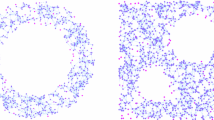Abstract
Wireless networks in which the node locations are random are best modelled as random geometric graphs (RGGs). In addition to their extensive application in the modelling of wireless networks, RGGs find many new applications and are being studied in their own right. In this paper we first provide a brief introduction to the issues of interest in random wireless networks. We then discuss some recent results for one-dimensional networks with the nodes distributed uniformly in (0,z). We then discuss some asymptotic results for networks in higher dimensions when the nodes are distributed in a finite volume. Finally we discuss some recent generalisations in considering non uniform transmission ranges and non uniform node distributions. An annotated bibliography of some of the recent literature is also provided.
Similar content being viewed by others
References
Appel M J B, Russo R 1997a The maximum vertex degree of a graph on uniform points in [0, 1]d.Adv. Appl. Probab. 29: 567–581
Appel M J B, Russo R 1997b The minimum vertex degree of a graph on uniform points in [0, 1]d.Adv. Appl. Prob. 29: 582–594
Bettstetter C, Hartmann C 2005 Connectivity of wireless multihop networks in a shadow fading environment.ACM/Kluwer Wireless Networks. Special Issue on Modeling and Analysis of Mobile Networks vol. 11
Bollobas B 1985Random graphs (Academic Press)
Borkar V S, Manjunath D 2005 A distributed control law for incremental power adaptation based topology control of ad hoc wireless networks. InProceedings of WiOpt-05, Trentino, Italy
Cheng Y C, Robertazzi T 1989 Critical connectivity phenomena in multihop radio models.IEEE Trans. Commun. 37: 770–777
Desai M P, Manjunath D 2002 On the connectivity in finite ad-hoc networks.IEEE Commun. Lett. 6: 237–239
Desai M P, Manjunath D 2005 On range matrices and wirelesss networks in d-dimensions. InProceedings of WiOpt-05, Trentino, Italy
Diaz J, Petit J, Serna M 1998 Random geometric graph in [0, 1]2. InRandomization and approximation techniques in computer science, Proc. Second Int. Workshop, RANDOM’98 (eds) M Luby, J D P Rolim, M J Serna (Lecture Notes in Computer Science 1518) (Berlin: Springer-Verlag)
Friedgut E, Kalai G 1996 Every monotone graph property has a sharp threshold.Proc. Am. Math. Soc. 124: 2993–3002
Giridhar A, Kumar P R 2005 Computing and communicating functions over sensor networks.IEEE J. Selected Areas Commun. (to appear)
Glaz J, Naus J, Wallenstein S 2001Scan statistics (Springer)
Godehardt E, Jaworski J 1996 On the connectivity of a random interval graph.Random Struct. Algorithms 9: 137–161
Goel A, Rai S, Krishnamachari B 2004 Sharp thresholds for monotone properties in random geometric graphs. InACM Symp. on Theory of Computing (STOC)
Grossglauser M, Tse D 2001 Mobility increases the capacity of wireless ad hoc networks. InProc. of IEEE Infocom, Anchorage, Alaska
Gupta P, Kumar P R 1998 Critical power for asymptotic connectivity in wireless networks. InStochastic analysis, control, optimization and applications: A volume in honor of W. H. Fleming (eds) W M McEneany, G Yin, Q Zhang (Boston: Birkhauser) pp 547–566
Gupta P, Kumar P R 2000 The capacity of wireless networks.IEEE Trans. Inf. Theor. 46: 388–404
Gupta P, Kumar P R 2003 Towards an information theory of large networks: An achievable rate region.IEEE Trans. Inf. Theor. 49: 1877–1894
Iyer S K, Manjunath D, Gupta B 2005 On the topological properties of one dimensional exponential random geometric graph. (submitted)
Karamchandani N, Manjunath D, Iyer S K 2005 On the clustering properties of exponential random networks. InProc. IEEE Int. Symp. World of Wireless, Mobile and Multimedia Networks (WoWMoM), Taormina, Italy
Khude N, Kumar A, Karnik A 2005 Time and energy complexity of distributed computation in wirelss sensor networks. InProc. IEEE Infocom
Kleinrock L, Silvester J A 1978 Optimum transmission radii in packet radio networks or why six is a magic number. InProc. Natl. Telecommunications Conference, Birmingham, pp 04.3.1–5
Kumar A, Manjunath D, Kuri J 2004Communication networking: An analytical approach (Morgan Kaufman)
Leese R, Hurley S 2002Methods and algorithms for radio channel assignment (Oxford: University Press)
McColm G L 2004 Threshold functions for random graphs on a line segment, Combinatorics,Probab.Comput. 13: 373–387
Panchapakesan P, Manjunath D 2001 On the transmission range in dense ad hoc radio networks. InProc. SPCOMM 2001
Penrose M D 1997 The longest edge of the random minimal spanning tree.Ann. Appl. Probab. 7: 340–361
Penrose M D 1999 On k-connectivity for a geometric random graph.Random Struct. Algorithms 15: 145–164
Penrose M D 2003Random geometric graphs (Oxford: University Press)
Santi P, Blough D M 2003 The critical transmitting range for connectivity in sparse wireless ad hoc networks.IEEE Trans. Mobile Comput. 2: 25–39
Xie L L, Kumar P R 2004 A network information theory for wireless communication: Scaling laws and optimal operation.IEEE Trans. Inf. Theor. 50: 748–767
Xue F, Kumar P R 2004 The number of neighbours needed for connectivity of wireless networks.Wireless Networks 10: 169–181
Zuniga M, Krishnamachari B 2006 Optimal transmission radius for flooding in large scale sensor networks.J. Cluster Comput. (to appear)
Author information
Authors and Affiliations
Rights and permissions
About this article
Cite this article
Iyer, S.K., Manjunath, D. Topological properties of random wireless networks. Sadhana 31, 117–139 (2006). https://doi.org/10.1007/BF02719777
Issue Date:
DOI: https://doi.org/10.1007/BF02719777




